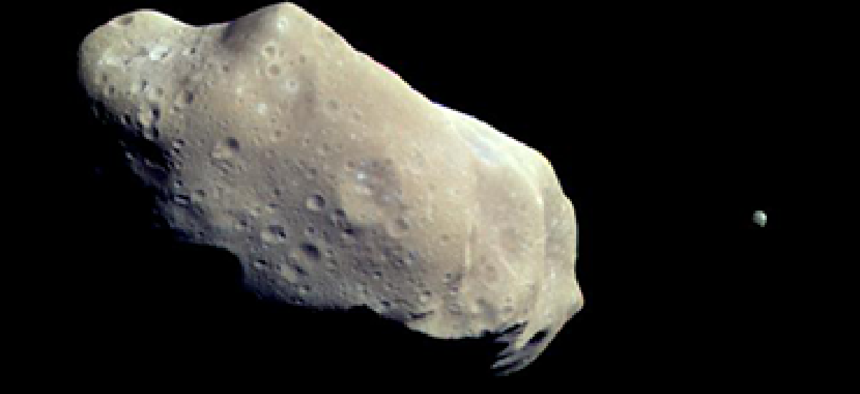Despite cuts, NASA has big plans for exploration and IT

Overall funding request is down, but key programs see significant bumps in Obama's budget request.

One of NASA's long-term goals is to capture an asteroid, like Ida pictured here, and bring it into Earth orbit for closer study. (NASA photo)
President Barack Obama's 2014 budget proposal shaves $50 million from NASA's discretionary budget and $27 million from the space agency's total IT budget compared to 2012 numbers. Yet agency officials said it was enough money to ensure the United States continues to be the world's leader in space exploration and scientific discovery.
Overall, NASA's requested $17.7 billion budget is a 0.3 percent decrease from pre-continuing resolution figures in 2012. The agency would receive about $1.44 billion in total IT investment, or a two percent decline from two years ago.
Yet topline numbers can be misleading, as NASA's Agency Information Technology Services (AITS) program would actually get a $10 million boost in funding, up to $168 million.
AITS provides the space agency a slew of IT services, including IT security policy, application management, incident monitoring, web services for the agency's 1,600 websites, end-user services and enterprise business applications. It is also charged with supporting data center consolidation and NASA's "Green IT" efforts. The extra cash for AITS allows NASA to move forward on several key IT initiatives over the next year, allowing the agency to carry out what the budget document refers to as a "cyber-security transformation" that will comply with IT security concerns voiced by NASA's inspector general.
Planned projects and initiatives include:
- Modernizing and expanding continuous monitoring and network penetration testing;
- Deploying intrusion detection systems across mission, corporate, and research networks;
- Increasing Web application security scanning;
- Implementing intrusion prevention systems;
- Mitigating vulnerabilities and risks, defending against cyber-attacks, protecting users from malware via e-mail phishing and better identifying and denying unauthorized data removal from NASA networks by developing an integrated security framework that promotes detection and protection across all the agency's centers.
NASA also used the April 10 budget announcement to reveal its request for $78 million to develop the technologies necessary for a robotic mission to lasso a small asteroid and move it to orbit around Earth. By 2025, NASA Administrator Charles Bolden said, astronauts would be able to explore the asteroid, and the agency is budgeting money for a manned mission to Mars by 2030.
"We are developing a first-ever mission to identify, capture and relocate an asteroid," Bolden said. "This mission represents an unprecedented technological feat that will lead to new scientific discoveries and technological capabilities and help protect our home planet."
Such efforts depend on congressional appropriations that at least resemble Obama's 2014 budget proposal. If sequestration is not resolved, NASA Chief Financial Officer Elizabeth Robinson said the agency will be limited in what it can do under the funding caps, whether it is strengthening IT initiatives or broadening humanity's knowledge of the universe.
"We won't be able to do the broad swath of activities that are planned here," said Robinson, when asked by a reporter what happens it sequestration continues.
"We'll face that when we get to it," she added.



